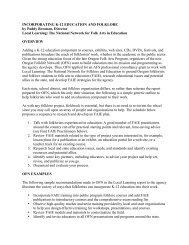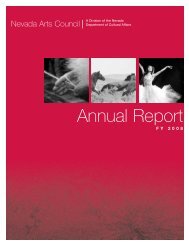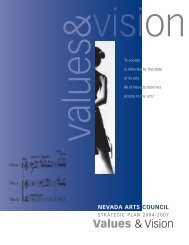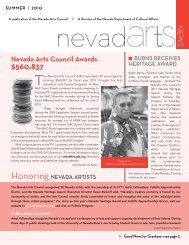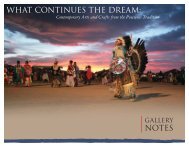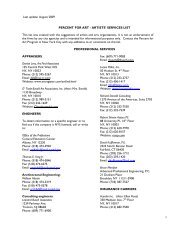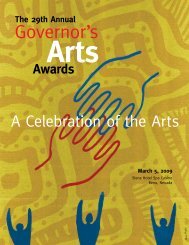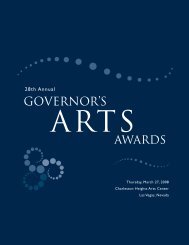Handed Down - Nevada Arts Council
Handed Down - Nevada Arts Council
Handed Down - Nevada Arts Council
Create successful ePaper yourself
Turn your PDF publications into a flip-book with our unique Google optimized e-Paper software.
1995–1996<br />
Mexican Dance:<br />
Icela Gutierrez, Reyna Esquivel and Gabriela Tshudy<br />
The multipurpose room of a community school in<br />
Las Vegas echoes with laughter and rapid-fire<br />
instructions in Spanish as Icela Gutierrez tries to get<br />
her students to line up for their next dance. She pushes<br />
the button of her tape player and the room fills with<br />
lively music. Icela runs to take her place among the<br />
dancers, calling out instructions even as she performs<br />
the steps herself, and that enthusiasm and camaraderie<br />
enliven the whole group.<br />
Although only 30, Icela has been performing and<br />
teaching the dances of her native Mexico for twenty<br />
years, and has recently brought her skills to southern<br />
<strong>Nevada</strong>. She knew no one when she moved here, so<br />
she put announcements in the local Spanish-language<br />
newspaper and on the radio asking for interested students,<br />
and in only a few months has created a close and<br />
enthusiastic group of young dancers.<br />
She chose to work with two dancers, Reyna Esquivel<br />
and Gabriela Tshudy, in passing on her broad knowledge<br />
of Mexican culture and dance. Both apprentices<br />
were raised in Mexico and are very proud of their heritage<br />
and anxious to share it with their new neighbors in<br />
<strong>Nevada</strong>.<br />
The members of Mexico Vivo, Icela Gutierrez’s dance troupe.<br />
Not much more than a year after the formation of<br />
the dance group, called Mexico Vivo, they are being invited<br />
to perform at schools and restaurants on a regular<br />
basis. At a rehearsal in the new Rafael Rivera Community<br />
Center, which opened in early 1996 to serve Las<br />
Vegas’ Hispanic community, the women’s bright full<br />
skirts swirl against the black cowboy shirts and sombreros<br />
of the men in a dance from Monterrey in northeast<br />
Mexico. The dancers whoop and stomp as they execute<br />
dramatic moves and interweaving choreography, mirroring<br />
Icela’s infectious ebullience and accomplished<br />
talent.<br />
Each region of Mexico has its own style of costume,<br />
music and dance that have been carried down for<br />
hundreds of years. One of the most popular and wellknown<br />
types of performing groups, both in Mexico and<br />
in Mexican-American communities, is the folklorico<br />
dance troupe, which performs dances of many regions.<br />
Just in the last five years in southern <strong>Nevada</strong> there has<br />
been a flowering of such groups, with Mexico Vivo one<br />
of the newest. Because sound and movement are something<br />
we all have in common, music and dance provide<br />
a way for people from different cultures to get to know<br />
one another, and as with any art form they highlight<br />
both what we share and what makes each of us unique.<br />
As a way to maintain a sense of cultural identity amid<br />
the frenzy of change in Las Vegas, folkloric dance plays<br />
an important role<br />
in the Mexican<br />
American community.<br />
As Gabriela<br />
wrote in her<br />
application to the<br />
program, “Folklore<br />
is an echo of<br />
the past, but at the<br />
same time it is also<br />
the vigorous voice<br />
of the present.”<br />
Icela Gutierrez<br />
37




